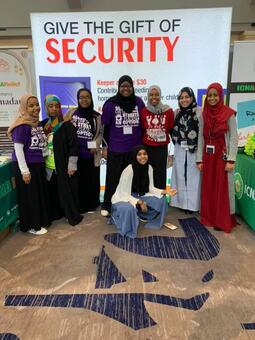 The issues our children are facing in this new century undoubtedly need to be addressed. There is so much happening in this quickly changing world and it’s hitting our children hard. Our children are dealing with issues that we didn’t deal with as we were growing up. They are exposed to violent video games like Fortnite and Grand Theft Auto. They must learn to protect themselves in schools from intruders. Who ever thought this would be an issue in a place of knowledge? There are so many sexual agendas presented to them such as transgenderism, homosexuality, and what pronoun does one identify with. This world is swiftly becoming tricky. What we once thought was common sense is no longer valid. So, my questions are, how do we guide them through this fast-paced changing world? How can we guide them to be the best Muslims they can be with all the dilemmas of society? I really think that we need to provide more halal outlets for our youth to help them navigate through the issues. We should be able to provide counseling sessions for youth who are struggling. It is up to our generation to be a source of guidance and support. We must be very careful of criticizing their decisions and help them find solutions through Islamic resources. I see an urgent need to bring back Islamic studies classes to listen and clarify some of the misguidance that our children face. It seems to be a major agenda against religion or people of faith. Our children are becoming confused of what to believe. As parents, all we can do is pray for them and ourselves regularly. There is a constant struggle for us all. In closing, I pray that Allah guide our children and keep their hearts full of faith, protect them from going astray, being led astray, and slipping.
3 Comments
 I am Fatimah Wadood, Field coordinator and Case Manager with ICNA Relief. I have been working and volunteering with this organization for a little over two years. In this short time of doing service, I have been able to see how practicing small acts of kindness truly has an impact on our communities. Over the past 5+ years, we've offered: Emergency rental assistance to avoid eviction. Feed the Hungry program every Sunday, where we offer hot plates to the homeless downtown totalling in 450+ bellys fed per month. Our annual Back to School giveway donates close to 2,000 free backpacks with school supplies to our communitys. A food pantry that offers a free supply of monthly groceries and toiletries. Our food pantry clients total to about 400 households per month. This alone has opened my eyes to see how many families are in true need of necessities as simple as bread, meat, and toilet paper. A lot of these families have homes, cars, full time employment, and even TANF benefits. But unfortunately with how iniquitous the economy has been, a full-time job it is not efficient enough to support a full family. This is why it's so important for our communities to help with emergency resources. It takes one small unfortunate event to demolish a household and result in homelessness. I recall during our coldest winter days, a refugee apartment complex had issues with their heating and air conditioning system. The units were occupied by large families with extreme hazardous living conditions. We partnered with Masjid Jafar and gave 80+ heaters to them. Knowing that the children could sleep better with a warmer home, made me appreciate even being able to afford a high power bill. We often take advantage of opportunities because we aren't aware of what a luxury it is, until it isn't anymore. Working with ICNA Relief continues to humble me in the saddest of ways. But it builds me up into being a more conscious force and voice for our communities. I encourage everyone to practice small acts of kindness. I prefer to say acts of kindness instead of "programs we offer," because at the end of the day our services don't create permanent change overnight. Continuous love and support to our communitues is what creates change in them.  By: YaQutullah Ibraheem MS, RDN, LD Registered Dietitian Nutritionist @yaqutu_nutritionprescriptions While food costs present a very real cost of living challenge for many families, Americans are finding ways to cope and are cutting back on other living expenses including transportation, clothing, recreational and other luxuries. We select food items based on food costs, taste, and preparation convenience. While all of these are important options to consider, none is more important than your long-term health and quality of life. Welcome to the final frontier. The American affinity for that which is quickest, easiest, and least expensive often results in our gravitating towards choices that are not always the healthiest which leads us to high sodium containing canned foods, processed foods high in fat and sugar that we think may be a quick fix for our hunger and that don’t break the bank, but you get what you pay for and you are what you eat. In the long run, quality nutrient content fall by the wayside as out waistlines expand and out blood pressures increase. With the steady rise in food costs of breads, grains and cereals, a 9% increase according to The Consumer Price Index, many Americans are resorting to discount food pantries, food banks, government assistance programs and other options in order to meet their nutrient needs. Meal planning, understanding what to purchase and how to get the most of it is key. Now don’t go and get rid of all of your favorite foods but learn to plan meals and add a bit of creative pizzazz to spice up some of the goods that you have in those cabinets. Here are a few tried and proven ways to maximize nutrient intake while minimizing monthly food costs for families and individuals. Meal Planning When meal planning, several factors come to mind including the number of family members being served, the number of total meals a family consumes at home, frequently purchased items, considerations for work and school lunches and other considerations. Eating breakfast at home can save an average of $900.00 dollars annually. Just think of how much a family of four could save by preparing daily lunches. When purchasing items, label reading is essential in order to get the most nutrition out of items purchased. Key nutrients include Folate, Iron, Vitamin C, Calcium, Vitamin A, protein, saturated fat, and fiber that help with vision, bone growth and development, lean muscle maintenance, brain function, and maintaining good bowel health and regularity. Trans-fats are restructured fat molecules not naturally occurring in nature that have been included in foods in order to increase shelf life and stability. Many items are now Trans fat-free, but when shopping for dairy and other animal products, look for items low in saturated fats, i.e., less than 2 grams per serving. As a general rule, items are a good source of a nutrient if it provides 10% or more of a particular nutrient and is an excellent source if the food item provides 20% or more of a particular nutrient. When it comes to health, quality wins out over quantity. For items that are frequently purchased, a bulk purchase from bulk food clubs including Sams Club, Cosco, BJs, and others, are more cost effective for whole wheat high fiber breads, grains, cereals and other non-perishable dry goods and freezable items. These items can be easily incorporated into prepared lunches and for breakfast at home. Rethink non-essential food items that offer little or no nutritional value such as soft drinks, cookies, candies and other impulse items. Meal Planning and Shopping Tips
Portion Control The average American eats 2-3 times the recommended portion size indicated on a Nutrition Facts Label. Pay attention to portion size and minimize plate waste by being aware of the number of servings in a food package. For example, when preparing meals at home pay attention to the number of servings per food container or package. For grain and cereals items ½ cup for hot cereals and ¾ for cold cereals is considered a serving size. Use this information to plan for the number of meal portions to be served and how many servings you can yield from items purchased. Portion control is also essential to adequate weight management. If dinning out is one of your favorite past times, be aware that the amount of food served is about 3 times the normal recommended portion size. So, don’t feel like you have to devour the entire entrée at one sitting. Eat a bit and save some for later. Snacking It’s natural to snack so why not plan a healthy way to do it? Instead of making multiple trips to the vending machine at work or school, save the change and purchase items including granola bars, yogurt, salt free pretzels, whole fruits, carrot sticks, whole wheat peanut butter crackers, and other healthy items that can be packed and taken with you to school or work. This is a great way to ensure good nutrition while also preventing unbudgeted expenses. Purchasing in Season Fruits and Veggies Using the weekly supermarket sale papers when shopping is a good habit that will help us shop sales and save money on food costs. Purchasing items fruits and vegetable in season such as squash, potatoes and other items in the fall and winter and berries and tropical fruits in summer allows you to save money and get a variety of nutrients throughout the year. Other items including many vegetables may be purchased fresh frozen, stored and used in meals. One way to begin is to know where you stand and make adjustments as necessary. Another way to know how much you spend on groceries is to keep a record of how much your family spends on food for a two-month period. After you collect this information, you can determine how to reduce your monthly food budget. Everyone has to eat, but you can eat healthy and cut budget costs significantly when you plan accordingly. Your healthy is your wealth so invest in it! Follow on IG for more nutrition tips and information @yaqutu_nutritionprescriptions [email protected]  by Zanaida Wakatama As of January 27, 2020, paper and electronic filings will now be received and processed, by the IRS, for refund or payment for this tax season. Before you rush to complete your taxes, let’s take a moment to make sure you have compiled necessary and pertinent information. Here are some suggestions to get you started. Choosing the standard or itemized deduction - The standard deductions for 2020 are as follows: Married Filing Jointly- $24,800, Married Filing Separately- $12,400, Head of Household-$18,650, Single- $12,400. Choosing the itemized deduction is only advantageous if you have high mortgage interest, give an exceptional amount to charity or pay high state and local taxes. Unless the latter apply, the standard deduction is best. Income from a job or contracted work- By now your employer or business for whom you worked as a contractor should have completed and sent out their required W-2s and 1099s. If you have not yet received your documents look forward to receiving them by mid February. Any delay beyond then should prompt you to contact Human Resources and if no response then contact the IRS for next steps to ensure that you enter accurate numbers to avoid penalization. Childcare expenses- If you have qualifying dependents, child under 17 or disabled person, for whom you pay for childcare you may be eligible for a tax credit of $2,000 per qualifying child. A bit of information is needed from the childcare provider to properly report the expense on your return. From your provider you may have received or need to request documentation that states their employer identification number (EIN) or social security number, the duration of service and total amount paid. Services can be received from establishments, individuals as well as family members that are not parents and live outside your home. Care provided only while you were working and not by a nanny or personal assistant can be reported. Record keeping- Whether you’re tech savvy or old school decide on a consistent format for saving your tax information. Choose a cloud platform to scan and upload your documents or take out the trusted manila folders to add your documents as you receive them. You will refer to either your actual or virtual folder when you are ready to reference them during the tax preparation process. A copy of the accepted return from the IRS should be added to the “folder” later for safekeeping. Once you’ve decided on your record keeping format and compiled all of your paperwork, go to a trusted tax preparer or office to file your 2020 tax return. You may visit the IRS website to locate businesses in your area. Tax returns are to completed by Wednesday, April 15, 2020. Happy Filing! Later issues will cover additional tax topics. What kinds of tax or financial topics would you like covered? |
Don't miss another edition of A Message from Makkah. Click the button below to join our mailing list
Contact Us for Advertising Opportunities!
Archives
January 2023
Categories
All
Our Sponsors |
Makkah International Institute



 RSS Feed
RSS Feed